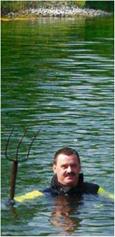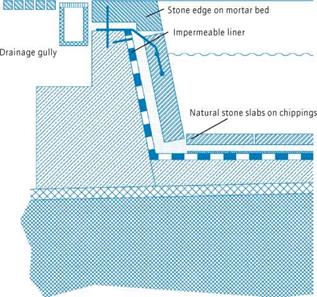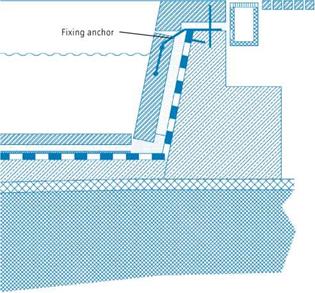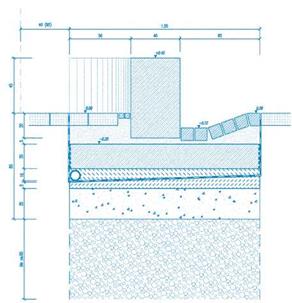Section through purification biotope
Water can be a problem in urban open spaces. Building water features seems prohibitively expensive, too many things can go wrong, and maintenance is too expensive. But when the water quality is right, pumps, filters and control devices are working properly, the parts of the building that come in contact with the water are not damaged and when water, along with light and sound effects, turns boring places into exciting ones, no one wants to be without it. But however easily and lightheartedly water flows and splashes – it needs expert handling in urban landscapes.
Constructed water features are always individual objects. They emerge from interplay between the possibilities offered by the site and clients’ and planners’ ideas and wishes. The techniques used to install and run them are as varied as the water features themselves. They are rarely to be had off the peg, but need a technical concept that is individually tailored to their location.
But on the other hand there are always standards and guidelines to be taken into account, for example those applying to the depth of the water or water hygiene. There are a wide range of regulations applying to these in different countries. Experience shows that these can be interpreted individually in terms of each particular situation. This is especially true if new and unconventional ideas are being realized: it is innovative concepts above all that mean thinking beyond existing norms. Here the key recommendation is that the responsible
authorities should be involved in the search for new solutions from the outset.
The following brings together a few hints on building and running water features that have emerged over the years from day-to-day work in the studio.
Sourcing and water quality
A fundamental criterion for the building and running of water features is the quality of the water. This is affected by physical, chemical and biological processes in the water itself and by its interplay with its immediate surroundings.
Water sourcing: Water features usually tap into the local water supply which generally means using drinking water.
It is also becoming increasingly attractive to think of using available surface run-off, drainage water or roof collected rainwater.
The origins and quality of water are crucial in terms of its possible use. When concerning a complex planning task, it is advisable to consult experts like limnologists to develop parameters for anticipated water quality. It is also important to identify questions about water hygiene and upkeep as quality requirements even during the design phase. Different standards apply according to the purpose for which the water is being used. The more the water comes into direct contact with people, for example with children playing, the more
![]()
|
|
||
|
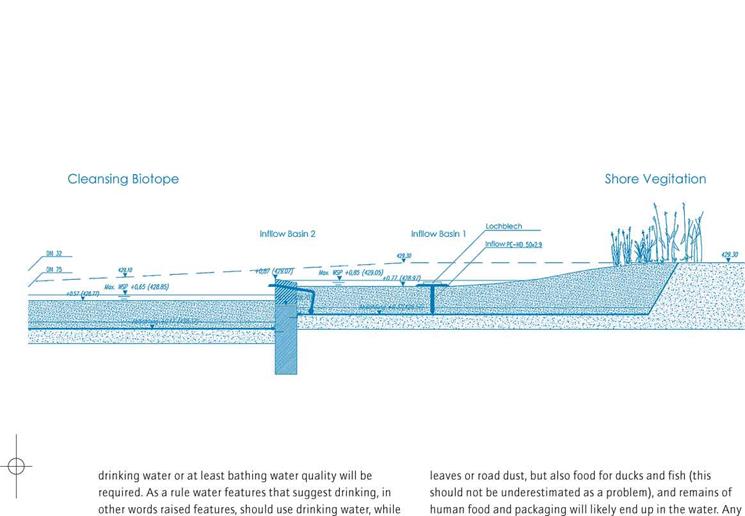



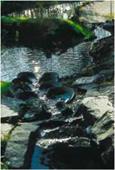

![]()
|
|
|
|
|
|
|
|
|
|



![]()
![]()
|
|
|
|||
|
|||||
|
|
||||
|
|||||
![]()
![]()
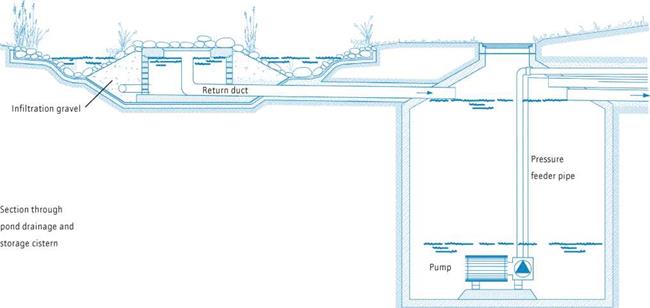
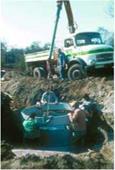
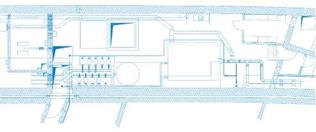


![]()
|
|
|
|
|
|
|
|
|
|
|
|
|
|
|
|
|


![]()


![]()
![]()

![]()


to the circulation tank, and should ideally be able to filter about 50 % of the total water in circulation.
We have found that naturally developed sand or bottom filters, here called purification biotopes, are suitable for many water features. They are particularly appropriate for features and systems that allow the watercourse to develop naturally to a certain extent, and that have sufficient space available. They have various advantages; they form second-hand biotopes, do not need any additional energy and are not expensive to maintain. As with any other planting, dead vegetable matter and foreign bodies have to be removed from time to time. The winter months are most suitable for this.
Regulation and monitoring: Every water system needs regulation. This ensures that the various input points are provided with the appropriate quantities of water at the required time. When the water level drops in the cistern or the body of water an electrical or mechanical sensor should monitor the water level and ensure that the necessary extra water is fed in. The control boxes and all the meters should always be installed above maximum water level in a separate shaft or in the cellars of an adjacent building. In the case of larger and more complex features there will be meters for certain parameters like pH value, temperature, oxygen content or nutrient levels in the water, working continuously or sporadically. These values then form a basis for precise analysis of the water.
Some clients like the feature to be monitored so that they can optimize development and also the maintenance of the system and the related costs on the basis of suggestions from experts.
Plant substrate Railway ballast 56/63 mm Sealing structure Drainage layer with pipe

![]()
|
|||
|
|
||
![]()
![]()



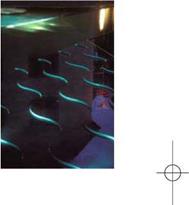

![]()
From the idea to the finished object
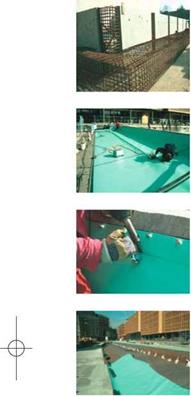
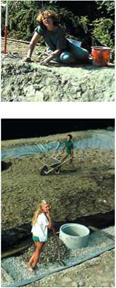
![]()
|
|
|
Tunnel roof |
Construction technology
Technical aspects of construction are of crucial importance for interesting water features with high design values. Interest is focused on the following four areas: sealing, foundations, materials and connections.
Sealing: Natural seals like clay can rarely be used in built water features. There are many sealing processes that are quite close to nature, but a certain diffusion loss has to be anticipated with all of them. Such processes are suitable only when continuous supply and constant water level are guaranteed.
When choosing a sealant the necessities arising from the specific situation have to be set off against the technical and financial input involved. The following criteria should be considered: the qualities of the building land, the geometry and surface of the feature, the desired water quality, the planned building phases and the cost.
Water features that are supplied and drained naturally make fewer demands in terms of sealing than those that rely on an artificial supply of drinking water or rainwater. However, minimal water loss should be a prime consideration even for small water features, for ecological and financial reasons.
Plastic sheeting is very adaptable as a sealing material, and is well suited to features with complex contours and very diverse geometry. But natural forms can be constructed with it as well. Many water features have to take differing settling rates into account. Flexible sheeting is suitable here, as it is
|
Section through piazza ditch to tunnel roof |
relatively easy to install on the spot, almost regardless of the weather. A whole variety of materials are available; of course their environmental friendliness must be given higher priority than technical suitability and economic viability.
If the substructure is something stable like concrete, for instance, a non-shrink grouting compound can also be used as a seal. It bonds firmly with the base and is simple to apply even if the geometry is complex. Coverings like natural stone slabs can be fitted directly to the rigid seal. This is also appropriate for fixed materials like concrete and steel, but does not work with flexible connections or expansion joints; other sealing processes have to be used here.
Water features in the shape of simple and rigid structures can be built in non-permeable concrete. However, these are appropriate only when the subsoil is stable, certain dimensions are not exceeded and walls of an adequate thickness can be built. The statics of water-proof concrete make it particularly suitable as a base for large prefabricated sections.
![]()
![]()

![]()
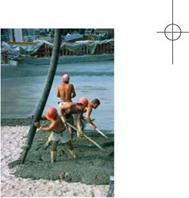
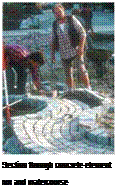
Foundations: Semi-natural lakes and ponds do not need rigid foundations. But fountains, pools and other built water features are particularly sensitive to subsoil settling, which can lead to cracks and leaks. What is usually needed here is foundations that can have a frost-free base and that are designed to meet the structural loading. The dimensions and thickness of the foundations are based on the weight, geometry, size and tolerance limit of the surface building.
Choice of materials: Unlike other structures, built water – features have surfaces that are always wet. For this reason it is important to use materials that are structurally stable and also frostproof in colder regions. Another important factor is that chemical and physical reactions of materials can be different and more aggressive in contact with water than in air, and vary with the characteristics of the water (pH value, temperature etc.). Building materials must be chosen to withstand such processes in the long term. Water quality must also be taken into account when choosing materials, as substances dissolved out of mortar or concrete can have a lasting deleterious effect on water chemistry.
In the case of earth and mineral substrates, chemical stability and the purity of the material are important factors. Organic components should be avoided wherever possible, as they raise nutrient levels and thus promote the growth of algae.
The colour of these materials is a key influence on the visual impact of the water; here dark shades are generally better for reflections on the surface of the water whereas-
lighter shades are suitable for showing reflections on the bottom. However, it is not so important to design the surface of these coverings elaborately, as the effect they make will be considerably reduced by the natural surface growth that occurs in any water. This growth can only be avoided by mechanical cleaning or the use of chemicals.
Water features in which people are intended to walk should have non-slip surfaces to minimize the risk of falling. Sharp-edged installations should also be avoided as they increase the risk of injury.
|
|
![]()
From the idea to the finished object
|
|
|
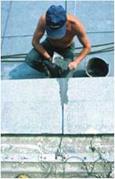
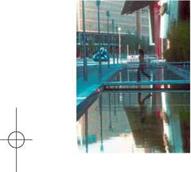

![]()


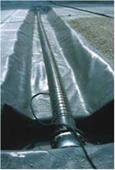

Interfaces: Natural watercourses are always in a state of dynamic interchange with their surroundings, losing water through outflow, evaporation and infiltration. Artificial water features would quickly lose their water to the surrounding area. To prevent this, the interface is particularly important, as well as sealing.
The interface between inflow, outflow, pipes and walls always presents a potential danger in terms of leaks; this is where most problems occur in practice. Different construction methods are required according to the nature of the seal. Connections through sheeting require fundamentally different flange constructions from those used for pierced concrete, for instance. For this reason precise and early planning is needed here, and particularly careful attention must always be paid to the construction and detailing of these points. Some specialist manufacturers offer prefabricated pipe ducting for seals of all kinds.
![]()
![]()
Construction option 3 Waterproof bottom
![]()
|
|
|
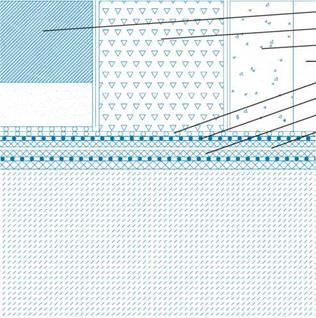
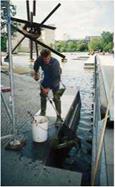
![]()

